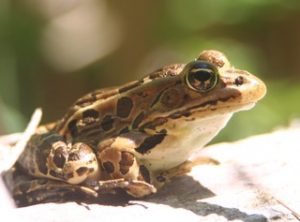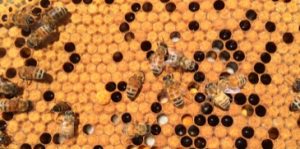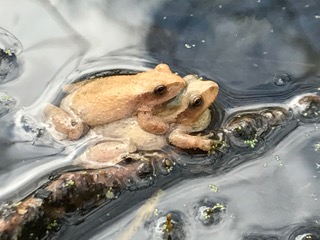Our primary research in the Belden Lab addresses the role of community composition in disease dynamics in a variety of systems:
Structure-function relationships in the amphibian skin microbiome
Our amphibian microbiome research is focused on a basic ecological question– what is the relationship between community structure and function in these complex symbiont communities. In an age of biodiversity loss, understanding the impacts of changing species diversity on function is increasingly important. We are particularly interested in the roles these microbial symbionts play in preventing disease. Infectious disease is devastating many amphibian populations. While much of my previous work has focused on identifying the causes of amphibian declines, one problem I have grappled with is what to do once we know the cause. How can we actually save amphibians? As part of our microbiome work, we are also addressing whether beneficial bacteria can prevent fungal infection. Beneficial bacteria (probiotics) are used in humans, livestock and for aquaculture. If we can learn enough about the bacterial microbiota that lives on amphibian skin, we may actually be able to use some of them for the treatment and prevention of disease in natural populations.
Systems biology of host-microbiome-parasite interactions in honey bees
 We recently received NSF funding to use the honey bee gut microbiome to expand our knowledge of the interactions that occur among host, microbiome and parasite genes to alter parasite exposure outcomes. Both network models and experimental manipulations of the gut microbiome will be used to further our understanding of the microbiome, and its role in host defense against a microsporidian parasite, Nosema. This project is being completed in collaboration with David Haak, T.M. Murali and Rick Fell, all at Virginia Tech, and Jenifer Walke at Eastern Washington University.
We recently received NSF funding to use the honey bee gut microbiome to expand our knowledge of the interactions that occur among host, microbiome and parasite genes to alter parasite exposure outcomes. Both network models and experimental manipulations of the gut microbiome will be used to further our understanding of the microbiome, and its role in host defense against a microsporidian parasite, Nosema. This project is being completed in collaboration with David Haak, T.M. Murali and Rick Fell, all at Virginia Tech, and Jenifer Walke at Eastern Washington University.
Individual- to population-level impacts of the house finch ocular microbiome on disease dynamics
We are collaborating with Dana Hawley at Virginia Tech, and Meghan May at the University of New England, on a newly-funded NSF project examining how the ocular microbiome of house finches can impact infection by a pathogen that causes conjunctivitis and how the microbiome of individuals can then impact population-level disease dynamics.
Wheat seed symbionts and fungal disease in crops
 I have loved plants since working as a plant field technician at the Sevilleta LTER in New Mexico after I graduated from college. But until recently, I had never done any research with them. After reading Dan Barber’s book, “The Third Plate”, I decided it was time to merge my love of food with my research program. And through some on-campus introductions and collaborations, we started a small project working on wheat seed endosymbionts. Wheat is a globally important staple grain crop, and faces threats from fungal pathogens and climate change. Trying to increase crop yield in the face of increased disease pressure and other major environmental stressors is a major challenge we face. Traditional wheat breeding can be done to select resistant strains for planting, and this can also be based on genetic screening for the presence of disease resistant alleles. However, microbial endophyte communities, the plant ‘microbiome’ that resides in plant tissues, constitute a relatively unexplored area of potential for crop improvement. So we are beginning to explore the role of seed endophytes in wheat development and disease resistance in collaboration with David Haak.
I have loved plants since working as a plant field technician at the Sevilleta LTER in New Mexico after I graduated from college. But until recently, I had never done any research with them. After reading Dan Barber’s book, “The Third Plate”, I decided it was time to merge my love of food with my research program. And through some on-campus introductions and collaborations, we started a small project working on wheat seed endosymbionts. Wheat is a globally important staple grain crop, and faces threats from fungal pathogens and climate change. Trying to increase crop yield in the face of increased disease pressure and other major environmental stressors is a major challenge we face. Traditional wheat breeding can be done to select resistant strains for planting, and this can also be based on genetic screening for the presence of disease resistant alleles. However, microbial endophyte communities, the plant ‘microbiome’ that resides in plant tissues, constitute a relatively unexplored area of potential for crop improvement. So we are beginning to explore the role of seed endophytes in wheat development and disease resistance in collaboration with David Haak.
Community composition and infection dynamics in freshwater trematode systems.
 Digenetic trematodes are a diverse group of parasitic flatworms (Phylum Platyhelminthes; Class Trematoda; Subclass Digenea). They can infect all vertebrate classes, and are common parasites in freshwater systems containing aquatic snails, which serve as obligate first intermediate hosts. Most digenetic trematodes infect three successive host species, although there is considerable variation in the life cycle. In an ecological sense, trematodes can be viewed as representative of a group of wildlife parasites and pathogens that have complex life-cycles involving multiple host or vector species that operate at very different spatial scales. We are focused both on understanding the factors that influence trematode dynamics in free-living wildlife populations, and also on using trematode systems as to elucidate some of the general underlying ecological mechanisms that facilitate patterns of host-parasite interactions across landscapes, especially in stream systems.
Digenetic trematodes are a diverse group of parasitic flatworms (Phylum Platyhelminthes; Class Trematoda; Subclass Digenea). They can infect all vertebrate classes, and are common parasites in freshwater systems containing aquatic snails, which serve as obligate first intermediate hosts. Most digenetic trematodes infect three successive host species, although there is considerable variation in the life cycle. In an ecological sense, trematodes can be viewed as representative of a group of wildlife parasites and pathogens that have complex life-cycles involving multiple host or vector species that operate at very different spatial scales. We are focused both on understanding the factors that influence trematode dynamics in free-living wildlife populations, and also on using trematode systems as to elucidate some of the general underlying ecological mechanisms that facilitate patterns of host-parasite interactions across landscapes, especially in stream systems.
